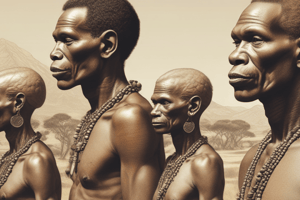Podcast
Questions and Answers
Which hypothesis suggests that humans spread out from Africa and wiped out other closely-related hominid species?
Which hypothesis suggests that humans spread out from Africa and wiped out other closely-related hominid species?
- Multiregional hypothesis
- Out of Africa hypothesis (correct)
- Homo erectus hypothesis
- Hominid evolution theory
The multiregional hypothesis is currently the most accepted theory of human evolution.
The multiregional hypothesis is currently the most accepted theory of human evolution.
False (B)
What is the scientific name for the human species?
What is the scientific name for the human species?
Homo sapiens
Humans evolved from the more primitive species known as __________.
Humans evolved from the more primitive species known as __________.
Match the following scientists to their contributions to human evolutionary theories:
Match the following scientists to their contributions to human evolutionary theories:
What evidence contradicts the multiregional hypothesis?
What evidence contradicts the multiregional hypothesis?
Most scientists agree on the exact timeline of human evolution.
Most scientists agree on the exact timeline of human evolution.
The __________ hypothesis proposes that different human populations evolved independently from their respective populations of Homo erectus.
The __________ hypothesis proposes that different human populations evolved independently from their respective populations of Homo erectus.
What does the Out of Africa hypothesis suggest about human evolution?
What does the Out of Africa hypothesis suggest about human evolution?
DNA evidence shows that populations closer to Africa have less genetic diversity.
DNA evidence shows that populations closer to Africa have less genetic diversity.
What type of evidence strongly supports the African replacement hypothesis?
What type of evidence strongly supports the African replacement hypothesis?
The multiregional hypothesis suggests that Homo sapiens evolved from Homo erectus ________.
The multiregional hypothesis suggests that Homo sapiens evolved from Homo erectus ________.
Match the following hypotheses to their main ideas:
Match the following hypotheses to their main ideas:
Which statement best describes Homo erectus?
Which statement best describes Homo erectus?
Most scientists currently support the multiregional hypothesis.
Most scientists currently support the multiregional hypothesis.
In terms of geographic distance, what trend is observed regarding genetic diversity?
In terms of geographic distance, what trend is observed regarding genetic diversity?
Fossils that support the ________ hypothesis were found outside of Africa, but are often poorly preserved.
Fossils that support the ________ hypothesis were found outside of Africa, but are often poorly preserved.
Match the following evidence types to their associated hypothesis:
Match the following evidence types to their associated hypothesis:
Why is using DNA to date fossils complicated?
Why is using DNA to date fossils complicated?
Fossils found in different regions imply complete isolation of Homo erectus populations.
Fossils found in different regions imply complete isolation of Homo erectus populations.
What is the estimated time frame since Homo sapiens left Africa?
What is the estimated time frame since Homo sapiens left Africa?
The ________ hypothesis posits that all modern humans are of African descent.
The ________ hypothesis posits that all modern humans are of African descent.
What does the multiregional model propose about the evolution of Homo sapiens?
What does the multiregional model propose about the evolution of Homo sapiens?
The multiregional model is the most widely accepted theory of human evolution.
The multiregional model is the most widely accepted theory of human evolution.
Who is referred to as 'Mitochondrial Eve'?
Who is referred to as 'Mitochondrial Eve'?
The multiregional hypothesis suggests that multiple populations of Homo erectus evolved into _____ in different regions.
The multiregional hypothesis suggests that multiple populations of Homo erectus evolved into _____ in different regions.
Match the following terms with their definitions:
Match the following terms with their definitions:
What evidence has significantly supported the Out of Africa theory since the 1990s?
What evidence has significantly supported the Out of Africa theory since the 1990s?
Neanderthals evolved directly from Homo erectus.
Neanderthals evolved directly from Homo erectus.
How has gene flow impacted the understanding of human evolution?
How has gene flow impacted the understanding of human evolution?
The Out of Africa hypothesis posits that Homo sapiens spread throughout _____ after evolving in Africa.
The Out of Africa hypothesis posits that Homo sapiens spread throughout _____ after evolving in Africa.
Match the following evidence to their respective theories:
Match the following evidence to their respective theories:
What is a key implication of the findings about Mitochondrial Eve?
What is a key implication of the findings about Mitochondrial Eve?
Fossil evidence shows that evolutionary changes occurred at the same time across different regions according to the multiregional hypothesis.
Fossil evidence shows that evolutionary changes occurred at the same time across different regions according to the multiregional hypothesis.
What is one criticism opponents of the multiregional hypothesis have?
What is one criticism opponents of the multiregional hypothesis have?
People with ancestry from outside Africa typically contain some _____ DNA besides their own.
People with ancestry from outside Africa typically contain some _____ DNA besides their own.
Which evidence suggests the multiregional hypothesis may have some validity?
Which evidence suggests the multiregional hypothesis may have some validity?
What is a major criticism of the multiregional hypothesis?
What is a major criticism of the multiregional hypothesis?
The Out of Africa hypothesis suggests that humans evolved independently in different regions of the world.
The Out of Africa hypothesis suggests that humans evolved independently in different regions of the world.
What scientific name is given to the human species?
What scientific name is given to the human species?
Homo erectus is believed to have evolved in Africa approximately ____ years ago.
Homo erectus is believed to have evolved in Africa approximately ____ years ago.
Match the following theories to their key ideas:
Match the following theories to their key ideas:
What do proponents of the multiregional hypothesis believe about Homo erectus?
What do proponents of the multiregional hypothesis believe about Homo erectus?
The Out of Africa theory is considered the most widely accepted theory regarding human evolution.
The Out of Africa theory is considered the most widely accepted theory regarding human evolution.
What genetic evidence supports the Out of Africa hypothesis?
What genetic evidence supports the Out of Africa hypothesis?
The ______ hypothesis suggests that adaptations in different geographic regions led to similar morphological traits in humans.
The ______ hypothesis suggests that adaptations in different geographic regions led to similar morphological traits in humans.
Match the following hypotheses to their main ideas:
Match the following hypotheses to their main ideas:
Study Notes
Human Evolution Theories
- Two primary theories explain human evolution: the multiregional hypothesis and the "Out of Africa" hypothesis.
- Human species known as Homo sapiens evolved from earlier species like Homo erectus, which originated in Africa approximately 1.9 million years ago.
Multiregional Hypothesis
- Developed by Milford H. Wolpoff, Alan Thorne, and Xinzhi Wu but has largely fallen out of favor.
- This theory posits that separate populations of Homo erectus evolved into Homo sapiens in various parts of the world, suggesting multiple origins of humanity.
- Fossil evidence outside of Africa indicates intermediate stages between Homo erectus and modern humans, initially supporting this hypothesis.
- Major scientific advancements in DNA analysis contradict the multiregional hypothesis.
- Critics highlight that similarities in fossils could result from parallel evolution due to environmental adaptations, not direct ancestry.
- DNA evidence shows that modern humans interbred with Neanderthals, indicating separate lineages of Homo erectus leading to distinct human groups.
- Genetic differences across people globally could also be attributed to gene flow from migration rather than independent evolution.
"Out of Africa" Hypothesis
- Widely accepted theory suggesting Homo sapiens evolved exclusively in Africa before migrating and replacing other hominid species.
- Gained significant support in the 1990s due to advances in DNA technology.
- Genetic studies revealed East African populations display the highest genetic diversity, implying all modern humans descended from groups that migrated out of this region.
- Mitochondrial DNA analysis traces all living humans to a common ancestor referred to as "Mitochondrial Eve," reinforcing African origins.
- Modern human populations have interbred with Neanderthals and Denisovans, with traces of their DNA found worldwide, indicating complexity in human evolution.
- New evidence suggests that early Homo species might have contributed genetic material to Homo sapiens during their migrations.
Comparative Evidence
- Multiregional hypothesis focuses on fossil records showing gradual evolution across various regions, while "Out of Africa" is supported primarily by genetic diversity and DNA studies.
- The multiregional theory lacks robust fossil evidence, as many fossils are poorly preserved or share traits with other Homo species, complicating claims of independent evolution.
- In contrast, genetic studies consistently show a reduction in diversity with increasing distance from Africa, favoring the "Out of Africa" theory as the more plausible explanation for human evolution.
Conclusion
- Ongoing research and discoveries in both fossil records and genetic analysis continue to shape our understanding of human evolution, indicating that complexity exists in how early humans interrelate and evolve.
- Disagreements among scientists highlight the challenges in categorizing and dating human evolution, influenced by varying interpretations of fossil and genetic evidence.
Human Evolution Theories
- Two primary theories explain human evolution: the multiregional hypothesis and the "Out of Africa" hypothesis.
- Human species known as Homo sapiens evolved from earlier species like Homo erectus, which originated in Africa approximately 1.9 million years ago.
Multiregional Hypothesis
- Developed by Milford H. Wolpoff, Alan Thorne, and Xinzhi Wu but has largely fallen out of favor.
- This theory posits that separate populations of Homo erectus evolved into Homo sapiens in various parts of the world, suggesting multiple origins of humanity.
- Fossil evidence outside of Africa indicates intermediate stages between Homo erectus and modern humans, initially supporting this hypothesis.
- Major scientific advancements in DNA analysis contradict the multiregional hypothesis.
- Critics highlight that similarities in fossils could result from parallel evolution due to environmental adaptations, not direct ancestry.
- DNA evidence shows that modern humans interbred with Neanderthals, indicating separate lineages of Homo erectus leading to distinct human groups.
- Genetic differences across people globally could also be attributed to gene flow from migration rather than independent evolution.
"Out of Africa" Hypothesis
- Widely accepted theory suggesting Homo sapiens evolved exclusively in Africa before migrating and replacing other hominid species.
- Gained significant support in the 1990s due to advances in DNA technology.
- Genetic studies revealed East African populations display the highest genetic diversity, implying all modern humans descended from groups that migrated out of this region.
- Mitochondrial DNA analysis traces all living humans to a common ancestor referred to as "Mitochondrial Eve," reinforcing African origins.
- Modern human populations have interbred with Neanderthals and Denisovans, with traces of their DNA found worldwide, indicating complexity in human evolution.
- New evidence suggests that early Homo species might have contributed genetic material to Homo sapiens during their migrations.
Comparative Evidence
- Multiregional hypothesis focuses on fossil records showing gradual evolution across various regions, while "Out of Africa" is supported primarily by genetic diversity and DNA studies.
- The multiregional theory lacks robust fossil evidence, as many fossils are poorly preserved or share traits with other Homo species, complicating claims of independent evolution.
- In contrast, genetic studies consistently show a reduction in diversity with increasing distance from Africa, favoring the "Out of Africa" theory as the more plausible explanation for human evolution.
Conclusion
- Ongoing research and discoveries in both fossil records and genetic analysis continue to shape our understanding of human evolution, indicating that complexity exists in how early humans interrelate and evolve.
- Disagreements among scientists highlight the challenges in categorizing and dating human evolution, influenced by varying interpretations of fossil and genetic evidence.
Studying That Suits You
Use AI to generate personalized quizzes and flashcards to suit your learning preferences.
Description
Test your knowledge on the multiregional model of human evolution. This quiz explores the theories surrounding Homo erectus migration and the simultaneous evolution of Homo sapiens in various regions. Understand the implications of this model and its significance in anthropology.




